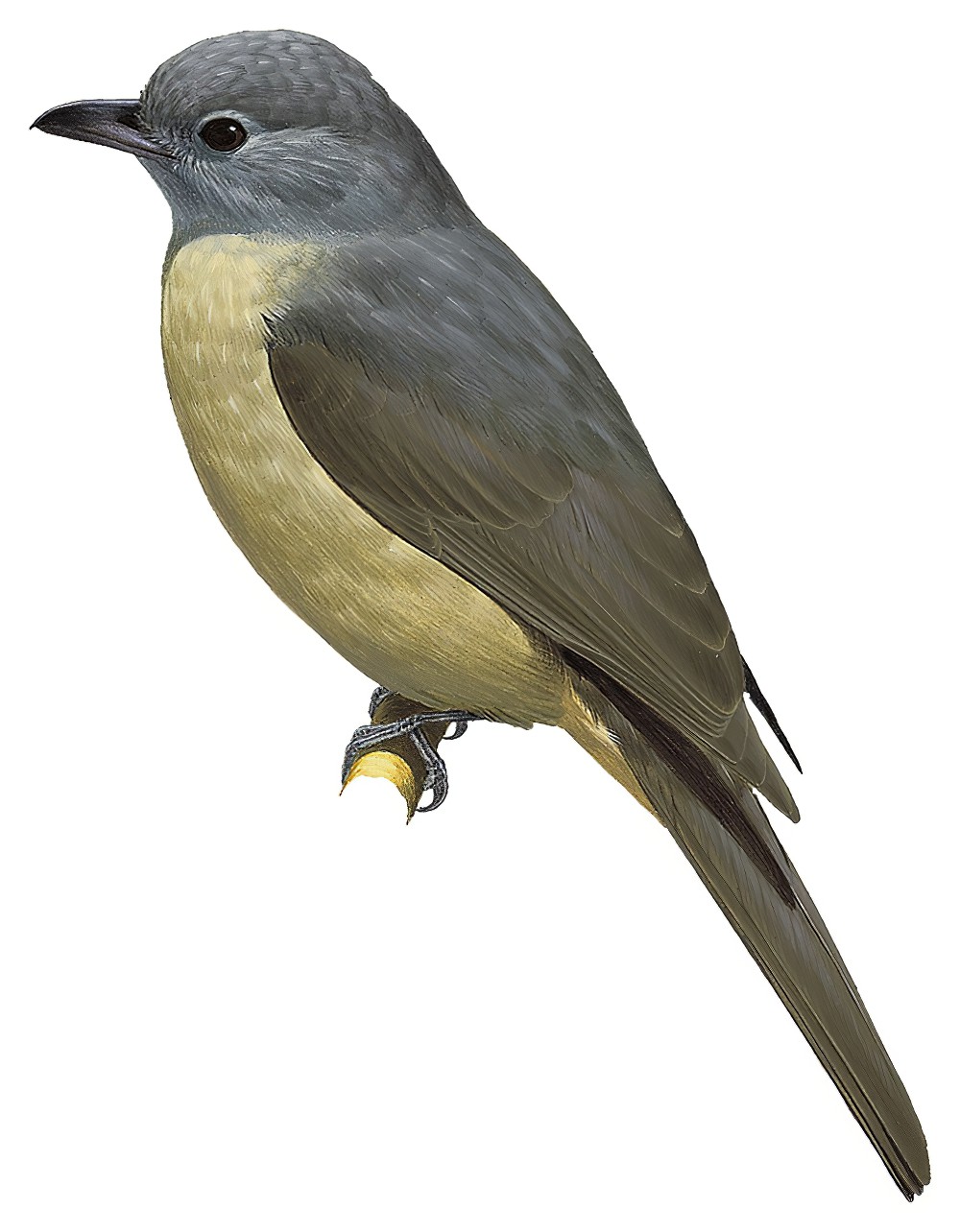Cinnamon-vented Piha / Lipaugus lanioides

Cinnamon-vented Piha
SCI Name:
Protonym: Turdampelis lanioides EchoMondeSav.(2), 11 no.7 col.156
Taxonomy: Passeriformes / Cotingidae / Lipaugus
Taxonomy Code: civpih1
Type Locality: Brazil; restricted to Rio de Janeiro by Pinto, 1944, Cat. Aves Brasil (Publ. Dept. Zool., Sao Paulo), pt. 2, p. 30.
Author: Lesson
Publish Year: 1844
IUCN Status: Near Threatened
DEFINITIONS
LIPAUGUS
(Cotingidae; Ϯ Screaming Piha L. vociferans) Gr. λιπαυγης lipaugēs dark, deserted by light < λειπω leipō to abandon; αυγη augē, αυγης augēs brilliance; "Gattung Lipangus.1 Hieher aus America: 1. Musc. simplex Lichst. 2. — turdina Pr. Max. 3. — ampelina Lichst. 4. — plumbea Pr. Max. 5. — cinerea Pr. Max. 6. — cinerascens Spix. Alle diese Vögel nähern sich durch ihre Gestalt den Würgern und Ampelis-Arten, und sind durch ihr bleygraues Gefieder ausgezeichnet. Nach den Beobachtungen des Prinzen Max von Wied leben sie in dichten Wäldern u. verrathen ihre Anwesenheit durch ein weitschallendes Pfeifen ... 1 Λιπανγος, splendore deficiens" (Boie 1828); "Lipangus (err. typ.1) Boie, 1828, Isis, p. 318. Type, by subsequent designation (G. R. Gray, 1840, List. Genera Birds, p. 29), Muscicapa plumbea Licht[enstein] = Muscicapa vociferans Wied. 1 The cited classical derivation, "λιπαυγσς [sic] = splendore deficiens," indicates a correctible error." (Snow in Peters 1979, VIII, 293).
Var. Lipangus (original spelling), Lipangis, Lipaujus.
Synon. Chirocylla, Chrysopteryx, Coraphos, Lathria, Lepageus, Tijuca, Turdampelis.
lanioides
Genus Lanius Linnaeus, 1758, shrike; Gr. -οιδης -oidēs resembling (e.g. heavy-billed).
● "L. Turdampelis lanioides, Lesson, g. et sp. nov." (Lesson 1844) (see Turdampelis) (Lipaugus).
● "PACHYCEPHALA LANIOÏDES. Pach. vertice, plumis auricularibus et pectore nigris; dorso posteriore fascia castanea ornato; gutture, abdomine medio, crissoque albis; dorso, lateribus, humeris, necnon primariis secundariis tectricibusque, externe, cinereis; cauda, rostro, pedibusque nigris. ... Hab. The north-west coast of Australia." (Gould 1840); "Distinctive, large, heavy-billed whistler of mangrove forests ... massive bill for catching large arthropods such as crabs" (Menkhorst et al. 2017) (Pachycephala).
Lanioides
(syn. Lanius Ϯ Lesser Grey Shrike L. minor) Genus Lanius Linnaeus, 1758, shrike; Gr. -οιδης -oidēs resembling; "It seems never to have occurred to anyone that the Lesser Grey Shrike (L. minor) should be separated from the larger, more sedentary species; yet it is unique amongst the shrikes in the shortness of the outermost primary. Its colour characters leave little room for doubt as to its affinity with the larger species and it is perhaps for this reason that taxonomers have so studiously avoided making use of the primary formulae in the diagnoses of the genera; but if we get down to facts we find that the same character is utilised in the case of other birds which have evolved in the same way and we must therefore recognise the difference. As no name is available I propose for this genus the name of LANIOIDES, genotype Lanius minor Gmelin, characterised as follows: first primary not extending beyond the primary coverts and only about one fourth of the length of the second; second primary longer than the fourth, third primary the longest; tail very much shorter than the wing (about 85 per cent.), the feathers graduated to about the length of the culmen and very much less than the length of the tarsus. Outermost tail feather somewhat narrower than in the typical Lanius." (A. Roberts 1922).
UPPERCASE: current genus
Uppercase first letter: generic synonym
● and ● See: generic homonyms
lowercase: species and subspecies
●: early names, variants, mispellings
‡: extinct
†: type species
Gr.: ancient Greek
L.: Latin
<: derived from
syn: synonym of
/: separates historical and modern geographic names
ex: based on
TL: type locality
OD: original diagnosis (genus) or original description (species)












